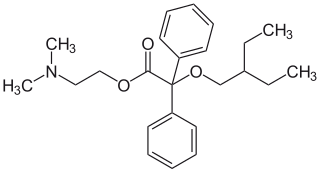 W
WAmbucetamide is an antispasmodic found to be particularly effective for the relief of menstrual pain. It was discovered in 1953 by Paul Janssen.
 W
WAmixetrine (INN) is a drug that was formerly marketed in France but is now no longer sold. According to various sources it has been said to be an anti-inflammatory, antidepressant, antispasmodic, anticholinergic, antihistamine, and antiserotonergic, but its definitive indications and pharmacology are unclear. The drug was first synthesized in 1969 and was introduced in France in 1972.
 W
WCarisoprodol, sold under the brand name Soma among others, is a medication used for musculoskeletal pain. Use is only approved for up to three weeks. Effects generally begin within half an hour and last for up to six hours. It is taken orally.
 W
WCinnamedrine, also known as N-cinnamylephedrine, is a sympathomimetic drug with similar effects relative to those of ephedrine. It also has some local anesthetic activity. Cinnamedrine was previously used, in combination with analgesics, as an antispasmodic to treat dysmenorrhea in the over-the-counter drug Midol in the 1980s. There is a case report of the drug being abused as a psychostimulant.
 W
WDenaverine is an antispasmodic drug. It was developed in Germany and patented in 1974. Denaverine hydrochloride is used in veterinary medicine under the trade name Sensiblex as a muscle relaxant for the myometrium of cows and dogs during parturition. Under the trade name Spasmalgan, it has also been used in humans for the treatment of urogenital and gastrointestinal spasms.
 W
WDicycloverine, also known as dicyclomine, is a medication that is used to treat spasms of the intestines such as occur in irritable bowel syndrome. It is taken by mouth or by injection into a muscle. While it has been used in baby colic and enterocolitis, evidence does not support these uses.
 W
WDrotaverine is an antispasmodic drug, used to enhance cervical dilation during childbirth.
 W
WHyoscyamine is a naturally occurring tropane alkaloid and plant toxin. It is a secondary metabolite found in certain plants of the family Solanaceae, including henbane, mandrake, angel's trumpets, jimsonweed, tomato, the sorcerers' tree, and deadly nightshade. It is the levorotary isomer of atropine and thus sometimes known as levo-atropine.
 W
WMagnesium citrate is a magnesium preparation in salt form with citric acid in a 1:1 ratio. The name "magnesium citrate" is ambiguous and sometimes may refer to other salts such as trimagnesium citrate which has a magnesium:citrate ratio of 3:2.
 W
WMoxaverine has been used in therapy based on the direct vasodilatory effect of the drug, a phosphodiesterase inhibitor, and on its influence on the rheological properties of red blood cells.
 W
WNepadutant (INN) (code name MEN-11420) is a glycosylated bicyclic cyclohexapeptide drug which acts as a highly selective NK2 receptor antagonist. It was developed by the Menarini Group and investigated for the treatment of functional gastrointestinal disorders and asthma but was never marketed.
 W
WOctatropine methylbromide (INN) or anisotropine methylbromide (USAN), trade names Valpin, Endovalpin, Lytispasm and others, is a muscarinic antagonist and antispasmodic. It was introduced to the U.S. market in 1963 as an adjunct in the treatment of peptic ulcer, and promoted as being more specific to the gastrointestinal tract than other anticholinergics, although its selectivity was questioned in later studies.
 W
WPapaverine is an opium alkaloid antispasmodic drug, used primarily in the treatment of visceral spasm and vasospasm, and occasionally in the treatment of erectile dysfunction. It is used in the treatment of acute mesenteric ischemia. While it is found in the opium poppy, papaverine differs in both structure and pharmacological action from the analgesic morphine-like compounds.